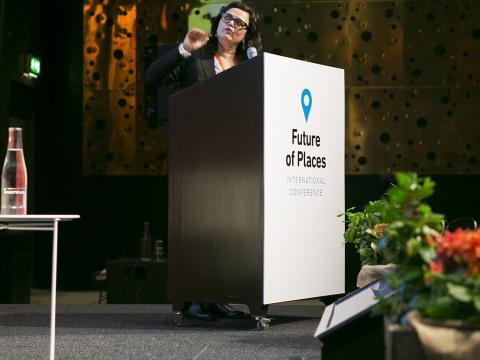Towards liveable spaces where children thrive

“All children have a right to grow up in a safe environment. Access to child friendly spaces is fundamental to the well-being of children,” said Joyati Das, Senior Director of World Vision's Urban Programmes, at the “Future of Places” Urban Thinkers Campus event held in Stockholm earlier this month.
Public space is a vital component of a prosperous city, and the state of public space is directly related to the quality of life for city residents. Yet, many children are living in overcrowded spaces in cities of the developing world where streets are contaminated with garbage and dangerous waste. They are exposed to gang violence and lack safe spaces to play, including adequate street lighting.
During a session on children’s well-being in relation to public space, World Vision shared a panel discussion with Stanford University and several Europe-based NGOs to present evidence about the need for genuine participation of children to shape public spaces. The panelists shared experiences from diverse and complex cities around the world, including examples from Asia, Latin America, Africa and the Middle East.
The case studies demonstrated the role of children as knowledge gatherers, users of ICT, and information providers through mapping positive and negative space, and social reporting on the usage of formal and informal space, thereby formalising their role by influencing city decision making processes.
The session explored examples of community-driven solutions and the inclusion of children’s voices in planning safe and healthy public spaces for children. These strategies are instrumental in changing the perception of children’s role in shaping liveable cities - a role which has traditionally been non-existent.
The session recommended four points for consideration for “The City We Need” emerging out of the campus:
- Knowledge: Children and youth are experts of their local communities and public space. This group should be considered as the knowledge bearers of the city to enhance city planning and policy making.
- Participation to influence policy: Children and youth as users of ICT could be a resource to influence transformation and change in their communities and city policy.
- Ownership: Consider children and youth as active participants in the management, maintenance and delivery of public space in their neighbourhoods and city.
- Call for action: Cities must include safe, playful, accessible spaces for children and youth to ensure that they grow up in a positive environment.
The session concluded by observing that when given the appropriate space and tools, children are able to actively advocate for the city they need - their right to playgrounds, green and clean spaces for better quality of life, street lights for safety, social inclusion and equity to ensure peaceful neighbourhoods in the city. This is fundamental to create a positive environment for the future leaders and citizens of the city.
Image: Panel members from the Future of Places’ session on children’s well-being in relation to public space.